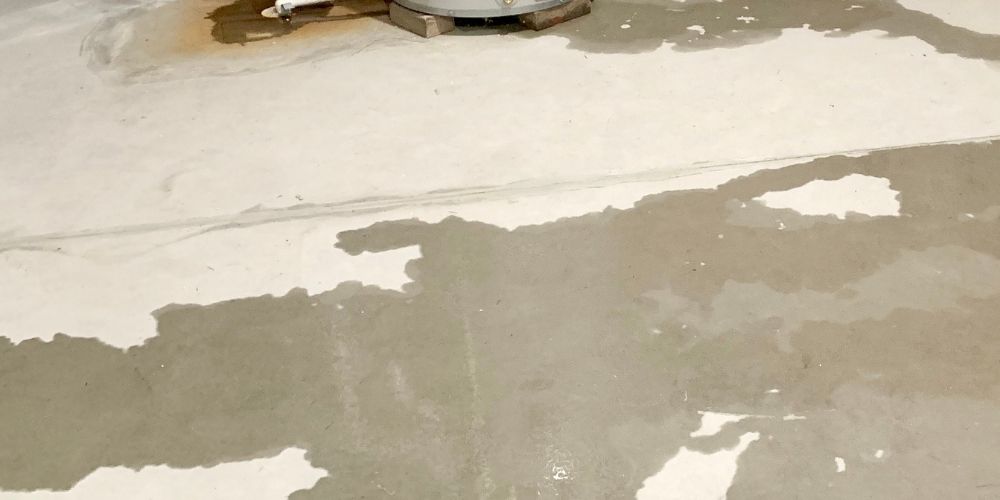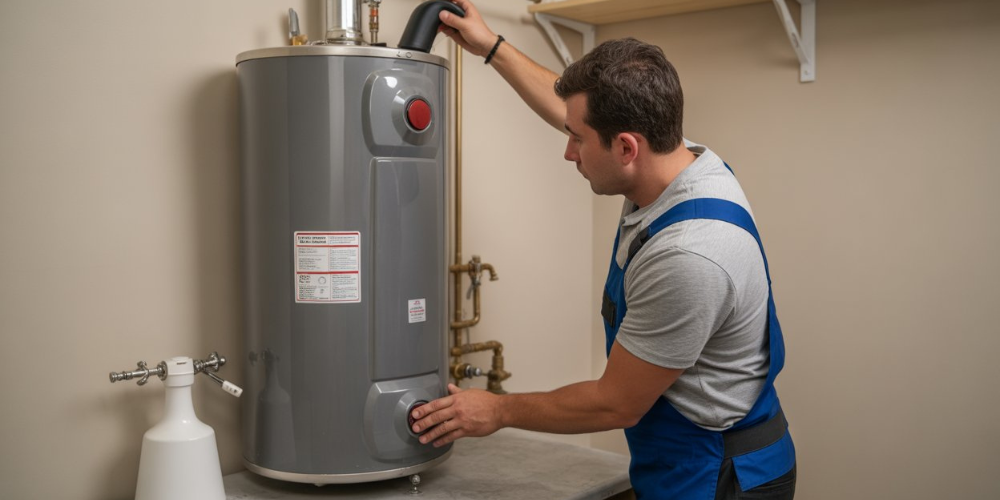When your drains stop working the way they should, it’s easy to assume the problem is just a blockage. But sometimes the issue runs deeper—literally. A collapsed drain is a serious plumbing problem where the pipe structure itself breaks down, restricting or completely cutting off water flow. If left unaddressed, it can result in severe property damage, health risks, and costly repairs.
Knowing the warning signs early can save you time, stress, and money. In this guide, we’ll explain the most common signs of a collapsed drain, how plumbers diagnose the issue, and what you can do to fix it.
What Is a Collapsed Drain?
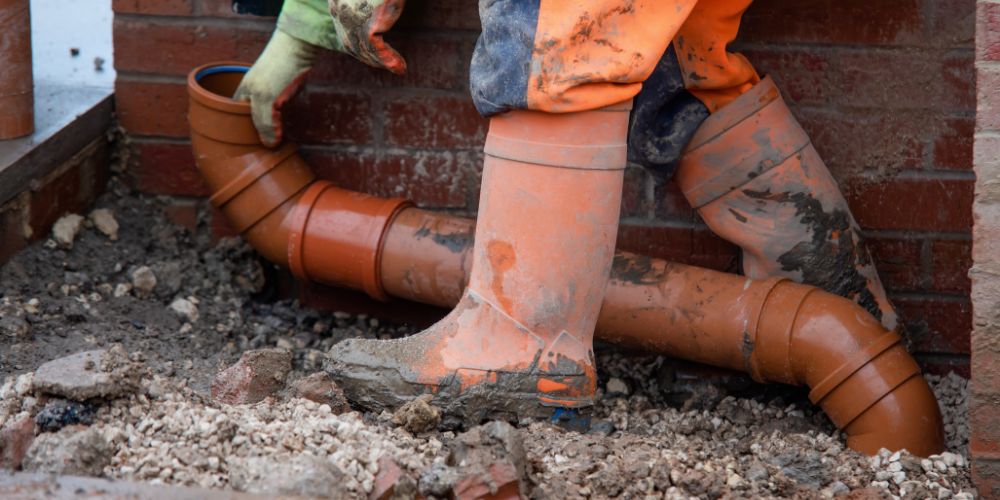
A collapsed drain occurs when part of your underground drainage pipe caves in or cracks beyond repair. Unlike a simple clog caused by grease or debris, a collapsed drain involves actual pipe damage.
Common Causes of Drain Collapse
- Aging pipes – older clay or cast iron pipes weaken over time.
- Tree root intrusion – roots grow into pipes, eventually breaking them.
- Ground movement – soil shifts, often from heavy rains or construction nearby.
- Excessive pressure – heavy vehicles or machinery above the drain can crush pipes.
Collapsed drains won’t fix themselves, and temporary DIY solutions won’t last. That’s why spotting the signs early is critical.
Also read, How to Unclog A Drain?
Early Warning Signs of a Collapsed Drain
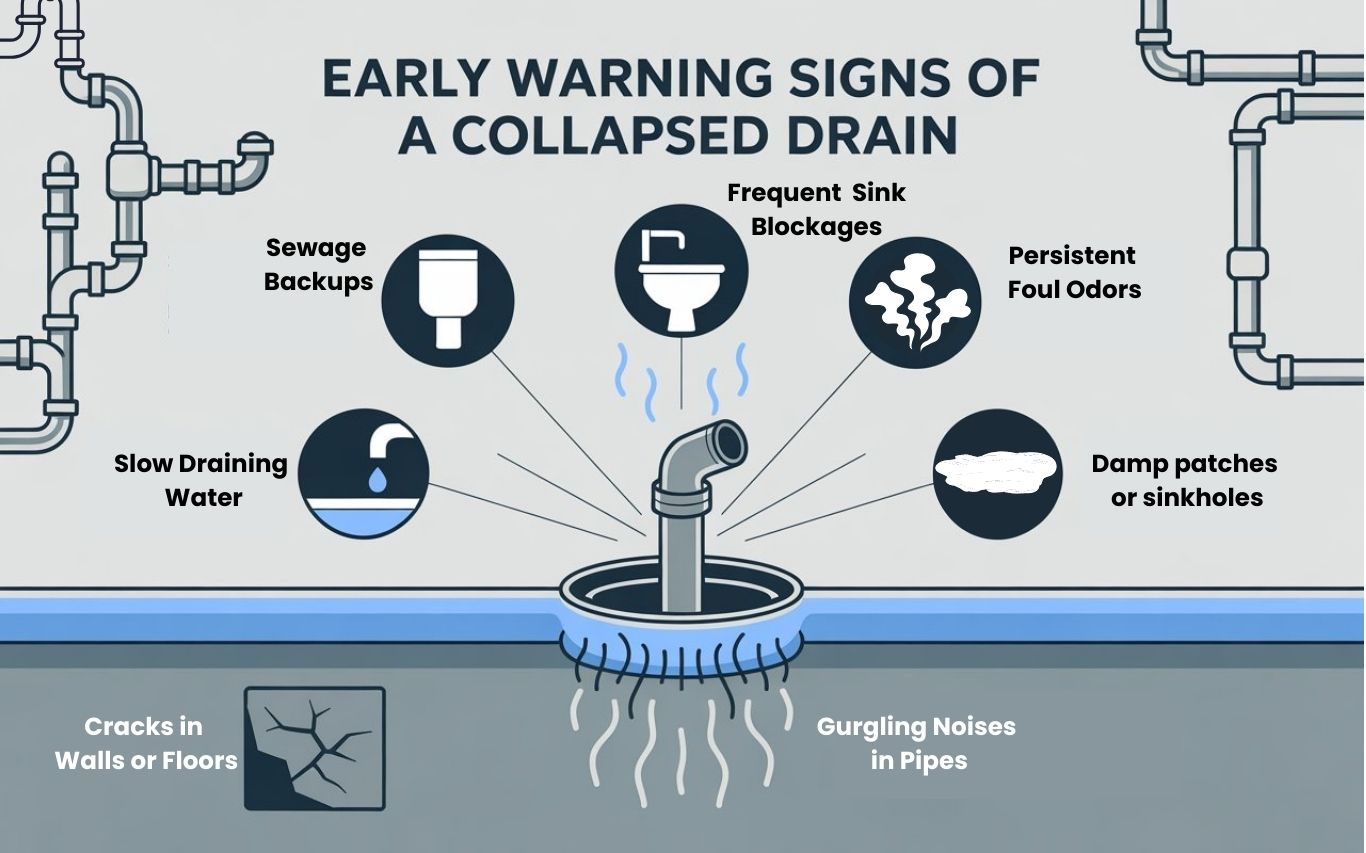
Quick Overview of Collapsed Drain Signs:
- Frequent blockages
- Slow draining water
- Persistent foul odors
- Gurgling noises in pipes
- Sewage backups
- Damp patches or sinkholes
- Cracks in walls or floors
1. Frequent Drain Blockages
If your drains continue to clog even after professional cleaning, the problem might not be buildup—it could be a collapsed section preventing smooth flow.
2. Slow Draining Water
Water taking longer than usual to drain from sinks, showers, or tubs often points to serious pipe damage, not just surface-level clogs.
Know How to Fix a Clogged Shower Drain?
3. Persistent Bad Odors
A strong sewage smell around drains or outside your property can indicate a broken or collapsed drain where waste is escaping.
4. Gurgling Sounds
Strange gurgling noises when flushing the toilet or draining water suggest trapped air caused by a collapsed pipe disrupting normal flow.
5. Sewage Backups
One of the most alarming signs—when wastewater backs up into your toilet, sink, or bathtub. This usually means the drain has failed.
Read, How to Unclog a Clogged Bathtub Drain
6. Damp Patches or Sinkholes
Unexplained wet patches on your lawn, driveway, or garden may signal leaking wastewater. In severe cases, small sinkholes may form.
7. Structural Damage
Cracks in your walls, floors, or foundation can occur if water is escaping from a collapsed drain and seeping into surrounding structures.
How Plumbers Diagnose a Collapsed Drain?
If you notice one or more of these warning signs, the next step is to call a professional plumber for a thorough diagnosis. Collapsed drains can be tricky to confirm without the right tools, which is why experts rely on advanced methods to pinpoint the exact issue. Here’s how a plumber typically diagnoses a collapsed drain:
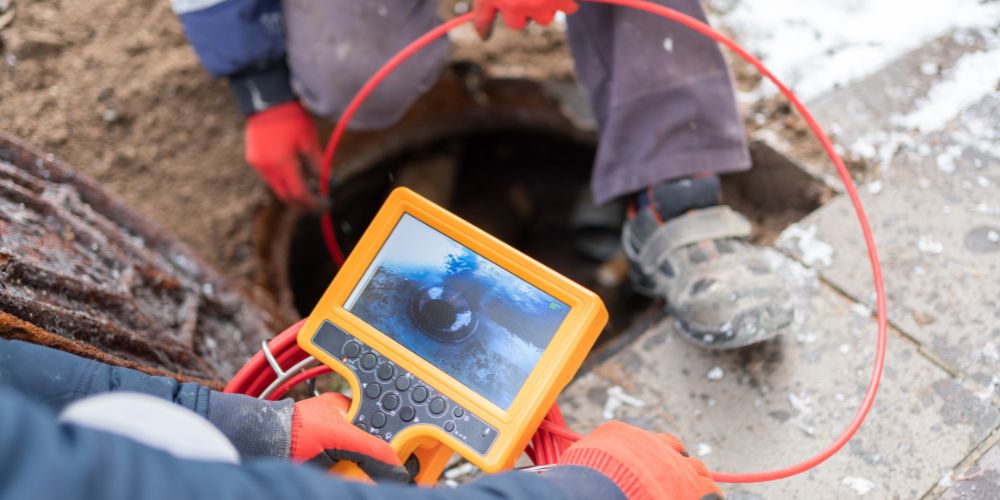
- CCTV Drain Inspection – A high-definition camera is inserted directly into the pipe, giving plumbers a clear view of the interior. This method allows them to spot cracks, blockages, or full collapses without digging up your yard or flooring.
- Smoke Testing – In this method, non-toxic smoke is pumped through the drainage system. If smoke escapes from areas where it shouldn’t—like your yard, walls, or floorboards—it’s a strong indicator of cracks, leaks, or collapsed sections of the pipe.
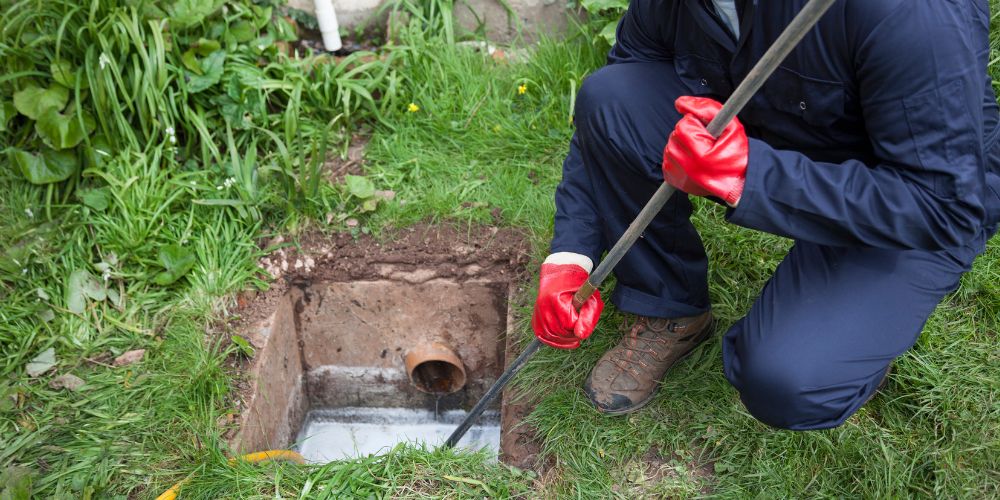
-
- Hydrostatic Pressure Testing – Plumbers may also run pressure tests by sealing sections of the drain and filling them with water. If the water level drops, it signals a leak or collapse within that section of pipe.
- Plumbing Inspection San Antonio – A full plumbing inspection by a licensed professional ensures nothing is overlooked. Beyond cameras and testing, plumbers check surrounding areas like the foundation, flooring, and soil for signs of water intrusion or erosion.
- Comprehensive Report & Repair Plan – After diagnosis, you’ll receive a detailed report of the issue, including images or video footage from the inspection. A trusted plumber will then recommend the best repair method—whether that’s a targeted pipe replacement, relining, or a full excavation if the damage is severe.
Solutions for a Collapsed Drain
When dealing with a collapsed drain, the right solution depends on the severity of the damage, pipe material, and property location. Acting quickly is crucial—leaving a collapsed pipe untreated can cause sewage backups, water damage, and even structural issues in your home.
1. Pipe Relining (Trenchless Technology)
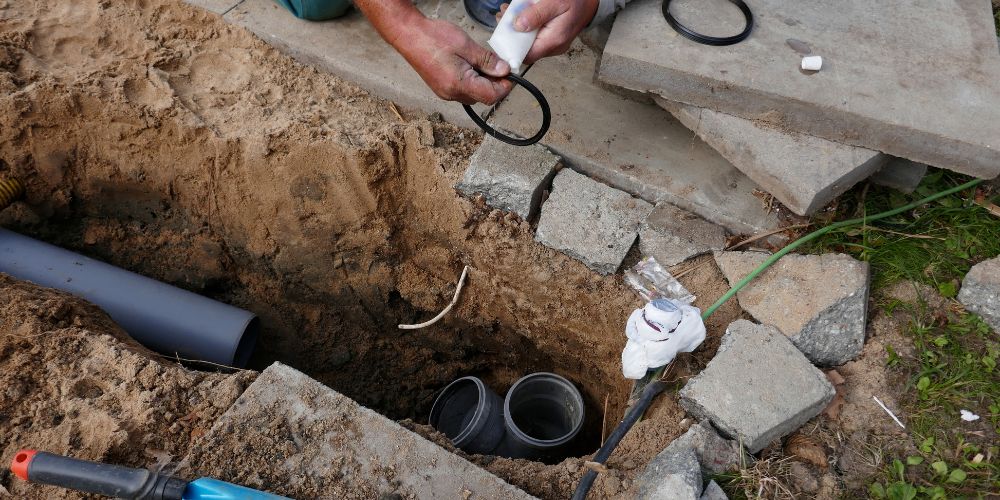
- How it works: A flexible resin liner is inserted into the old, damaged pipe. Once cured, it forms a new, seamless inner wall inside the existing drain.
- Benefits:
- Minimal digging required, protecting your landscaping and flooring.
- Quicker and more cost-effective than full excavation.
- The lifespan of relined pipes can be up to 50 years with proper maintenance.
- Best for: Partial collapses or pipes that are cracked but structurally stable enough to hold the lining.
2. Drain Excavation & Replacement
- How it works: The damaged pipe is dug out and replaced with a new one, usually PVC or HDPE.
- Benefits:
- Permanent solution for severe collapses or fully disintegrated clay/cast iron pipes.
- Ensures the entire pipe is brand new and built to current code.
- Drawbacks:
- More disruptive—requires digging up flooring, driveways, or yards.
- More expensive and time-consuming compared to trenchless methods.
- Best for: Complete drain collapses or when trenchless repair isn’t feasible due to soil conditions or pipe condition.
3. Hydrojet Cleaning (When Collapse is Partial)
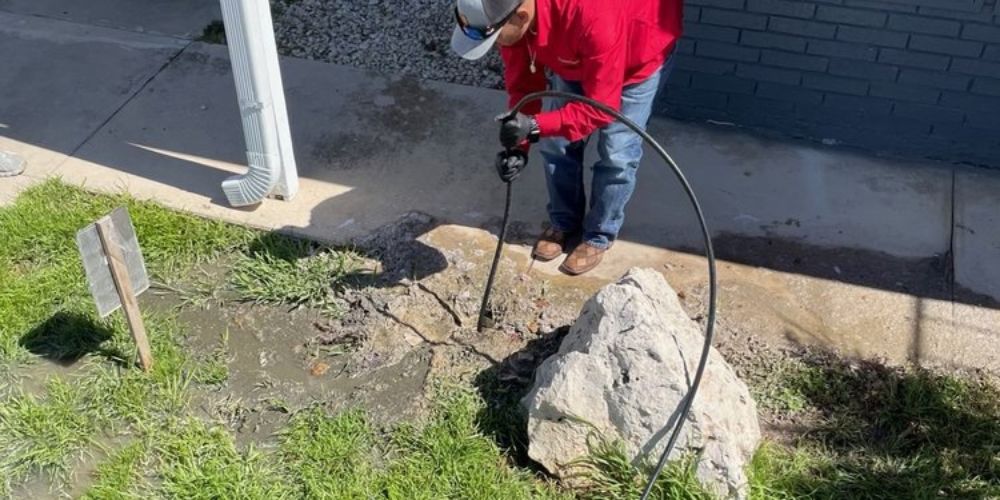
- How it works: High-pressure water jets blast away debris, scale, and tree roots inside the pipe.
- Benefits:
- Restores water flow in partially blocked or collapsed drains.
- Often used before pipe relining to clear the interior.
- Limitations:
- Only effective if the pipe still maintains enough structural integrity to withstand high water pressure.
- Best for: Early-stage collapses where blockages are caused by root intrusion, grease buildup, or mineral deposits.
Why DIY Isn’t an Option
Trying to fix a collapsed drain with DIY methods like plungers, drain cleaners, or makeshift patches won’t work. Without specialized tools (like inspection cameras, hydrojet systems, or relining equipment), you risk:
- Worsening the collapse.
- Damaging nearby pipes.
- Creating hazardous sewage backups.
A professional plumbing inspection with a drain camera is the safest way to identify the extent of damage before choosing a solution.
Preventing Drain Collapse
While not all causes can be prevented, regular maintenance reduces the risk.
- Schedule routine plumbing inspections to catch small cracks before they collapse.
- Be mindful of what you flush—avoid wipes, grease, and other non-degradable items.
- Manage tree roots with root barriers or professional trimming.
- Fix leaks early before they weaken the drain system.
Why Call a Professional Plumber?
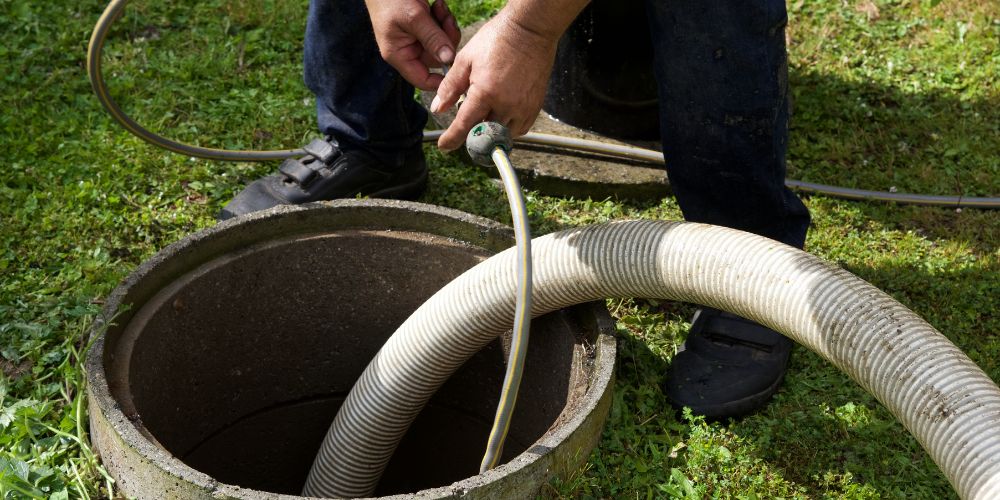
Collapsed drains aren’t just inconvenient—they can be hazardous. Ignoring the signs could lead to raw sewage leaks, structural damage, or even health risks from contamination.
A professional plumber has the expertise, tools, and experience to:
- Accurately diagnose the problem.
- Provide long-lasting repair options.
- Prevent further costly damage.
At PlumbSmart, we specialize in expert drain repair in San Antonio. Whether it’s a simple inspection or a complete drain replacement, our team is ready to restore your home’s plumbing quickly and reliably.
Conclusion
A collapsed drain is more than a plumbing inconvenience—it’s a serious issue that can damage your property, create health risks, and lead to costly repairs if ignored. By paying attention to early warning signs like frequent blockages, foul odors, sewage backups, or damp patches, you can catch the problem before it escalates.
When it comes to something this critical, quick action and professional expertise make all the difference. Don’t wait until a small problem becomes a disaster—reach out to the trusted team at PlumbSmart. Our San Antonio plumbers are ready with advanced tools and proven solutions to inspect, repair, and restore your drains with minimal disruption.
Call PlumbSmart today for reliable collapsed drain repair in San Antonio and protect your home from costly damage.



